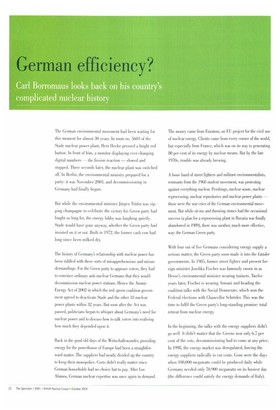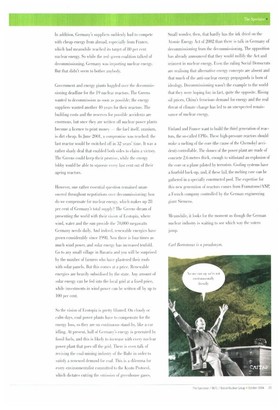German efficiency.
complicated nuclear history
The German environmental movement had been waiting for this moment for almost 30 years. In PDOM no. 5601 of the Stade nuclear power plant, Herr Hecke pressed a bright red button. In front of him, a monitor displaying ever changing
digital numbers the fission reaction — slowed and stopped. Three seconds later, the nuclear plant was switched off. In Berlin, the environmental ministry prepared for a party: it was November 2003, and decommissioning in Germany had finally begun.
But while the environmental minister Jargen Trittin was sipping champagne to celebrate the victory his Green party had fought so long for, the energy lobby was laughing quietly. Stade would have gone anyway, whether the Green party had insisted on it or riot. Built in 1972, the former cash cow had long since been milked dry.
The history of Germany's relationship with nuclear power has been riddled with these sorts of misapprehensions and misunderstandings. For the Green party to appease voters, they had to convince ordinary anti-nuclear Germans that they would decommission nuclear power stations. Hence the Atomic Energy Act of 2002 in which the red—green coalition government agreed to deactivate Stade and the other 18 nuclear power plants within 32 years. But soon after the Act was passed, politicians began to whisper about Germany's need for nuclear power and to discuss how to talk voters into realising how much they depended upon it.
Back in the good old days of the Wirtschaftswunder, providing energy for the powerhouse of Europe had been a straightforward matter. The suppliers had neatly divided up the country to keep their monopolies. Costs didn't really matter since German households had no choice but to pay. After los /Alamos, German nuclear expertise was once again in demand.
The money came from Euratom, an EU project for the civil use of nuclear energy. Clients came from every corner of the world, hut especially from France, which was on its way to generating 30 per cent of its energy by nuclear means. But by the late 1970s, trouble was already brewing.
A loose band of street fighters and militant environmentalists, remnants from the 1968 student movement, was protesting against everything nuclear. Pershings, nuclear waste, nuclear reprocessing, nuclear repositories and nuclear power plants — those were the war cries of the German environmental movement. But while sit-ins and throwing stones had the occasional success (a plan for a reprocessing plant in Bavaria was finally abandoned in 1989), there was another, much more effective, way: the German Green party.
With four out of live Germans considering energy supply a serious matter, the Green party soon made it into the Iiirmier governments. In 1985, former street lighter and present foreign minister Joschka Fischer was famously sworn in as Hesse's environmental minister wearing trainers. Twelve years later, Fischer is wearing Armani and heading the coalition talks with the Social Democrats, which won the Federal elections with Chancellor Schroder. This was the time to fulfil the Green party's long-standing promise: total retreat from nuclear energy.
In the beginning, the talks with the energy suppliers didn't go well. It didn't matter that the Greens won only 6.7 per cent of the vote, decommissioning had to come at any price. In 1998, the energy market was deregulated, forcing the energy suppliers radically to cut costs. Cone were the days when 100,000 megawatts could be produced daily while Germany needed only 70,9(X) megawatts on its busiest day (the difference could satisfy the energy demands of Italy).
In addition, Germany's suppliers suddenly had to compete with cheap energy from abroad, especially from France, which had meanwhile reached its target of 80 per rent nuclear energy. So while the red–green coalition talked of decommissioning, Germany was importing nuclear energy. But that didn't seem to bother anybody.
Government and energy giants haggled over the decommissioning deadline for the 19 nuclear reactors. The Greens wanted to decommission as soon as possible; the energy suppliers wanted another 40 years for their reactors. The building costs and the reserves for possible accidents are enormous, hut once they are written off nuclear power plants become a licence to print money — the fuel itself, uranium, is dirt cheap. in June 2(K)I , a compromise was reached: the last reactor would be switched of in 32 years' time. it was a rather shady deal that enabled both sides to claim a victory. The Greens could keep their promise, while the energy lobby would be able to squeeze every last cent out of their ageing reactors.
However, one rather essential question remained unanswered throughout negotiations over decommissioning: how do we compensate for nuclear energy, which makes up 28 per cent of Germany's total supply? The Greens dream of presenting the world with their vision of Ecotopia, where wind, water and the sun provide the 70,000 megawatts Germany needs daily. And indeed. renewable energies have grown considerably since 1998. Now there is four times as much wind power, and solar energy has increased tenfold. Co to any small village in Bavaria and you will be surprised by the number of farmers who have plastered their roofs with solar panels. But this comes at a price. Renewable energies are heavily subsidised by the state. Any amount of solar energy can be fed into the local grid at a fixed price, while investments in wind power can be written off by up to 100 per cent.
So the vision of reotopia is pretty blurred. ()it cloudy or calm days, coal power plants have to COnnwnSate for the energy loss, .so they are on continuous stand-by, like a car idling. At present, half of Germany's energy is generated by fossil fuels, and this is likely to increase with every nuclear power plant that goes off the grid. There is even talk of reviving the coal-mining itolustry or the Buhr in order to satisfy a renewed demand for roof This is a dilemma for every environmentalist committed to the Kyoto Protocol, which dictates cuttiitg the emission of greenhouse gases. Small wonder, then, that hardly has the ink dried on the Atomic Energy Act of 2002 than there is talk in Germany of decommissioning from the decommissioning. The opposition has already announced that they would nullify the Act and reinvest in nuclear energy. Even the ruling Social Democrats are realising that alternative energy concepts are absent and that much of the anti-nuclear energy propaganda is born of ideology. Decommissioning wasn't the example to the world that they were hoping for; in fact, quite the opposite. Rising oil prices, China's ferocious demand for energy and the real threat of climate change has led to an unexpected renaissance of nuclear energy.
Finland and Fr nice want to build the third generation of reactors, the so-called EPits. These high-pressure reactors should make a melting of the core (the cause of the Chernobyl accident) controllable. The domes of the power plant are made of concrete 2.6 metres thick, enough to withstand an explosion of the core or a plane piloted by terrorists. Cooling systems have a fourfold back-up, and, if these fail, the melting core can be gathered in a specially constnicted pool. The expertise for this new generation of reactors comes from Framatome/ANP, a French company controlled by the German engineering giant Siemens.
Meanwhile, it looks for the moment as though the German nuclear industry is waiting to see which way the voters jump.



















































































































 Previous page
Previous page